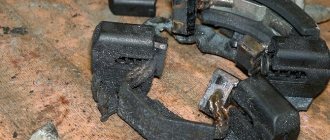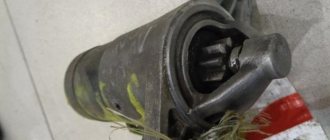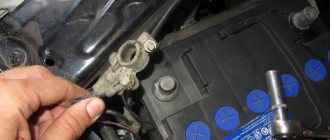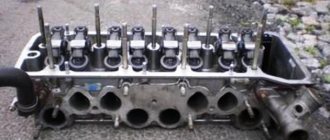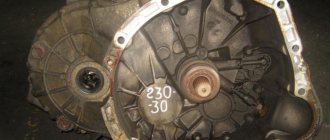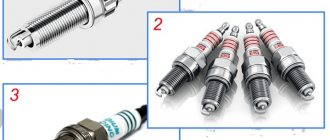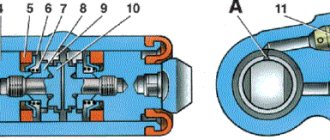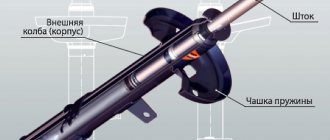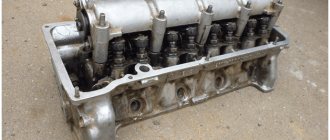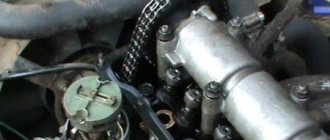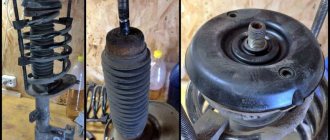Exhaust system design of VAZ 2107
Like most passenger cars, the VAZ 2107 has an exhaust system consisting of three main parts:
- a receiving pipe into which gases enter from the exhaust manifolds;
- VAZ 2107 resonator (additional muffler), where gases are directed from the exhaust pipe and where the exhaust sound is partially reduced;
- muffler, which absorbs most of the engine exhaust noise.
In addition to the above parts, the exhaust system includes:
- muffler mounting pad;
- pillow bolt;
- muffler suspension belt;
- clamp bolt and clamp securing the muffler to the resonator;
- clamp bolt and clamp securing the resonator to the exhaust pipe;
- clamp bolt and clamp securing the exhaust pipe to the body;
- nuts securing the exhaust pipe to the manifold;
- pad;
- locking plate;
Types of products
You can buy the following types of mufflers for the domestic brand:
- assembly model “Izh-Auto”, which is suitable for VAZ 2104, 2106 and 2107;
- model for a sedan body, which is suitable, in addition to the VAZ 2107, on varieties 2101, 2103, 2105 and 2106.
The following types of exhaust systems are available on the market:
- stamped and welded. They involve stamping two metal parts of the product can, welding them and attaching them to the pipe. Initially, exhaust systems were made in this way, but then the more reliable rolling method replaced it;
- sunset Involves wrapping sheet metal around the muffler. Despite the reliability of the method, factory parts are made only by the first method, so you can purchase roll-up exhaust systems separately.
Differences between the exhaust systems of carburetor and injection VAZ models
Installation of an injection system on a VAZ 2107 required modernization of the exhaust system. Two additional details were added to it:
- an oxygen sensor that determines the composition of the mixture, which is embedded in the exhaust manifold;
- an exhaust gas catalyst (“catalyst”), which is installed in front of the resonator, in the central tunnel under the bottom.
In connection with the installation of the catalyst, the VAZ 2107 resonator (injector) was moved a little back.
The new exhaust system has become a little more complicated, but it allows for a reduction in the toxicity of the VAZ 2107 exhaust and ensures that the car complies with EURO-2 standards.
Advantages and disadvantages of the injection modification of the VAZ 2107
The “Seven” in injection version and with a modernized exhaust system has a number of advantages over the old “carburetor” model. They are as follows:
- thanks to the injector, the engine operates more stable in all modes;
- the specific power and torque of the injection engine are higher;
- the exhaust of a VAZ 2107 with an injection system is cleaner than smoke from a carburetor engine;
- Driving a car with an injection engine is easier, it is not so demanding on the driver’s qualifications and “forgiven” mistakes when operating the gas and clutch pedals.
But installing the injector at the same time worsened some performance characteristics:
- the clearance of the injection “seven” decreased to 7 cm, which worsened its cross-country ability;
- due to the installation of the catalyst, the “survivability” of the exhaust system has decreased;
- the high temperature of the catalyst sometimes causes grass and dry leaves to ignite when the car is stopped.
Problems with the muffler and other elements
The main noise reduction section of the VAZ 2107 lasts for 10-50 thousand kilometers. Such a wide range is explained by different product quality and operating conditions. The service life of the receiving pipe and resonator lies within the same limits.
The occurrence of muffler malfunctions is characterized by the following symptoms:
- the appearance of a rumble from the exhaust system, in advanced cases turning into a loud roar;
- constant dull knock - the pipe touches the bottom of the car;
- a more rare malfunction is a complete engine failure, the power unit does not start and shows no signs of “life”.
On injection VAZ 2107 models, malfunction of oxygen sensors causes increased fuel consumption, unstable operation of the power unit and loss of power.
Condensate accumulating in the tank provokes corrosion and the formation of through holes
A rumble and roar indicate burnout of the exhaust pipe or muffler tank, which occurs for the following reasons:
- natural wear and tear of metal;
- through damage from an impact or shot from the engine;
- the effects of corrosion caused by a large amount of condensate that accumulates at the bottom of the tank.
Typically, burnouts occur at the welded joints of pipes with muffler or resonator tanks. If the housing is leaky due to corrosion or mechanical stress, the defect is visible on the bottom of the element. Often the exhaust “cuts” - gases break through at the junction of two sections due to a loosening of the connecting clamp.
Loose pipe connections are sometimes indicated by leaks of condensate escaping along with smoke.
While teaching my wife to drive a 7, a friend of mine unsuccessfully chose a site with a low parapet instead of a curb. While backing up, the girl hit the road fence with her muffler. Since the part had already worked for a decent period of time, the impact was enough to pierce the body through.
The tank or pipe touching the bottom of the car occurs due to stretched or torn rubber hangers. Rocking and impacts cause a dull annoying knock, which can be eliminated by replacing the rubber bands.
Stretching or breaking of rubber suspensions causes dull knocks from the muffler
If the engine is absolutely “dead”, it is worth checking the catalyst of the injection “seven” or the tract itself for blockages. A completely blocked section of the pipe will not allow gases to be ejected from the cylinders and a new portion of the combustible mixture to be drawn in.
A clogged or clogged catalyst can be identified by a quiet hiss of air coming from one of the pipe joints. When you repeatedly try to start the engine, the pistons pump air into the clogged exhaust system, which, under pressure, begins to escape through leaks. If you unscrew the “pants” from the manifold and repeat the start, the engine will probably start.
I had a chance to see a completely clogged pipe personally when a friend asked me to start the car using the pushrod (the battery was discharged due to prolonged rotation of the starter). The attempt failed, we moved on to diagnosing the ignition and fuel supply systems. A quiet hiss of air from the manifold was noticed when checking the carburetor. It turned out that the owner added a “good” additive to the fuel, which caused the formation of soot, which completely clogged the exhaust tract.
A housing rupture occurs due to a strong impact or as a result of a shot from the exhaust manifold.
Exhaust system functions and parts replacement intervals
Despite its apparent simplicity, the exhaust system performs several important functions:
- removal of fuel combustion products;
- reduction of noise level from the exhaust;
- maintaining air balance in intake and exhaust systems;
- ensuring ventilation and cleaning of cylinders;
- reduction of CO content (in the presence of a catalyst).
Exposure to high temperatures, moisture, fuel and oil combustion products leads to through corrosion of exhaust system parts. This is aggravated by the external influence of gravel, sand and salt solutions that are used to treat roads in winter. Therefore, parts of the system have to be changed. The frequency of replacement depends on the following factors:
- car use activity;
- frequency of machine operation in bad weather (rain, snow);
- fuel quality;
- quality of exhaust system parts.
Replacing the muffler VAZ 2107
The VAZ 2107 muffler (injector and carburetor) is connected to the resonator with a clamp, which is located in front of the rear axle. Before removing the clamp, it should be tapped with a hammer to make it easier to unscrew the threaded connection and uncouple the pipes. To change the muffler, you need to do the following:
- loosen the clamp bolt and remove (move) the clamp;
- pull the flared muffler pipe off the resonator (if that doesn’t work, knock it down with a hammer and chisel);
- remove the muffler from the cushion and mounting straps;
- install a new muffler on the VAZ 2107;
- tighten the clamp.
What muffler can be installed on the “seven”
There are 4 options for replacement:
- Standard VAZ 2101-2107 muffler made of ordinary steel with anti-corrosion coating. The plus is the low price of the product, the minus is the unpredictable duration of work. When purchasing, it is quite difficult to evaluate the quality of the metal and workmanship, unless the welds are made completely carelessly.
- Factory section made of stainless steel. The option is not cheap, but durable. The main thing is not to buy a fake made from cheap Chinese metal.
- The so-called direct-flow sports muffler, manufactured in a factory.
- Weld the outlet element of the desired design yourself.
Standard mufflers are made of ordinary metal with an anti-corrosion coating
If you do not have welding skills, the fourth option is automatically eliminated. All that remains is to choose between stock and sports parts.
A straight-through muffler differs from a standard muffler in the following ways:
- shape - round, outlet of larger diameter;
- design - inside is a straight perforated pipe, lined with fireproof sound-absorbing material;
- the operating sound is low-frequency, louder.
The factory-made direct flow is painted on the outside with heat-resistant paint, the pipe outlet is equipped with a decorative nozzle
The forward flow resistance is significantly less than the factory model of the muffler. The design makes it possible to ventilate the cylinders more efficiently and increase engine power by up to 5 hp. With. A side effect is a higher noise level, which brings pleasure to fans of extreme driving.
The stock design muffles noise due to several internal partitions and additional perforated pipes, causing gases to change direction and be reflected repeatedly from obstacles. Hence the high resistance of the element and a small drop in power.
In a conventional element, sound and gases change the direction of movement several times; in a direct flow, they are dissipated through the perforation of the pipe
Tuning enthusiasts install forward flow in combination with other means - zero-resistance filters, turbines, and so on. Replacing a standard muffler with a direct-flow muffler without performing other measures will give one result - a loud rumble, you will not feel an increase in engine power.
It is not difficult for a car enthusiast who owns a welding machine to make a forward flow independently:
- Make a round tank from sheet metal (you will need rollers) or select a ready-made can from another car brand, for example, Tavria.
- Place a perforated pipe inside, having previously drilled many holes with a diameter of 5-6 mm.
It's easier to make slits in a pipe, but it's better to spend more time making the holes - Fill the cavity between the straight channel and the walls tightly with non-flammable basalt fiber.
- Weld the end walls and supply pipes. A curved element from an old muffler is perfect as an inlet pipe.
If desired, the direct flow can be made double - then the noise level will decrease - At the required points, attach 3 fasteners corresponding to the standard hangers.
You can refine the outlet pipe using a nickel-plated decorative nozzle. The choice of products in size and shape is extremely wide, the prices are quite affordable.
Video: making a direct flow with your own hands
Replacing the VAZ 2107 resonator
The VAZ 2107 resonator does not have fastening parts to the car body, so it is necessary to hold it when replacing it. Otherwise the exhaust pipe will be bent.
The replacement work consists of the following steps:
- tap clamps and pipe connections with a hammer;
- loosen the bolts of the clamps and move the clamps fastening to the “pants” and the muffler;
- disconnect the resonator from the muffler by undocking the pipes;
- disconnect the resonator from the receiving pipe (“pants”);
- install the new resonator in the correct position;
- connect the parts and tighten the fastening clamps.
Note: the resonator tank must be parallel to the ground, otherwise the part will knock on the bottom of the car and cling to uneven road surfaces.
How are knocking and muffler position related?
If the muffler suddenly starts knocking on some parts of the car, find the source of the extraneous sounds. Usually the reason lies in stretched rubber fasteners. After replacing them, the knocking will stop.
Sometimes a knock appears after work related to removing the muffler. In this case, extraneous sounds are a consequence of installation errors. Round pipes at the joints with clamps can be slightly rotated relative to the correct position: more or less than required, pushed into each other.
DETAILS: Replacing the VAZ 2114 manifold Photo instructions on how to replace the manifold on a VAZ 2114
To eliminate knocking, restore the optimal position of the exhaust system elements.
Sagging mufflers can be “treated” using similar methods—by replacing rubber bands and correcting the position of joints.
Replacing the exhaust pipe (“pants”) of a VAZ 2107
When replacing the exhaust pipe, be sure to replace the gasket between it and the exhaust manifold. It is also better to change the nuts securing the “pants” to the manifold. The procedure is as follows:
- loosen the clamp and disconnect the pants from the resonator;
- unscrew the four nuts securing the exhaust pipe to the manifold;
Important: unscrew the nuts carefully so as not to twist the fastening studs. Otherwise, you will have to drill out and replace the studs.
- remove the “pants” (exhaust pipe) and gasket;
- install a new gasket;
- install a new exhaust pipe;
- connect the exhaust pipe to the resonator, tighten the fastening clamp;
- tighten the nuts securing the “pants” to the manifold.
If, after installing a new exhaust pipe, the exhaust system sags or hits the bottom, the following options are possible:
- the resonator or exhaust pipe is fixed at the wrong angles;
- engine mounts sagged.
In the first case, it is enough to loosen the clamps and install the parts correctly. In the second case, the engine mounts will have to be replaced.
Exhaust System Mounting Parts
The clamps and suspension elements of the exhaust system are exposed to moisture and salt during machine operation. In addition to corrosion, metal “fatigue” accumulates in clamps. The clamps begin to loosely hold the connection, as a result of which exhaust gases begin to break out, creating noise. Old suspension cushions may break off, which can damage exhaust system parts. Therefore, it is advisable to change the mounting parts; whenever large parts are replaced, the mounting elements on which they are attached should also be changed. This will avoid unnecessary problems and expenses.
